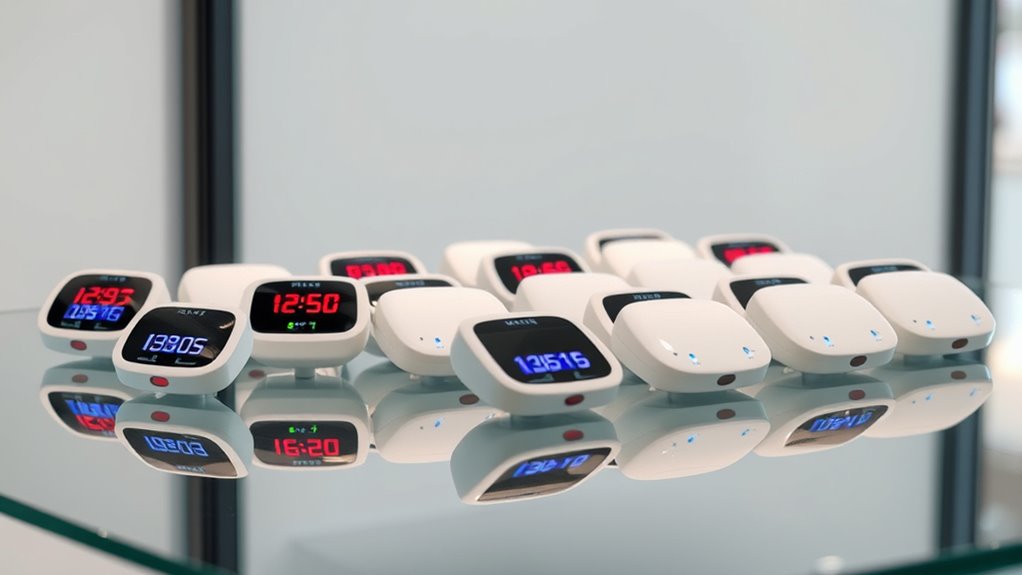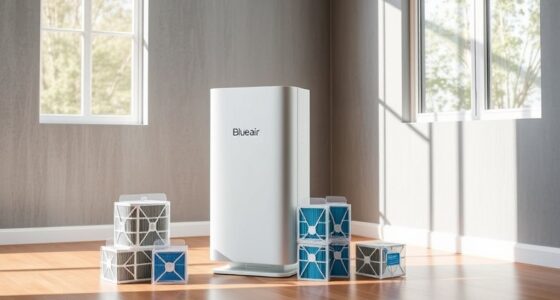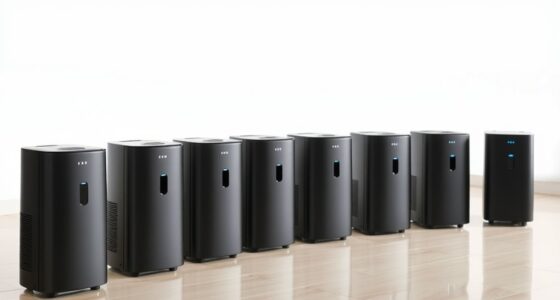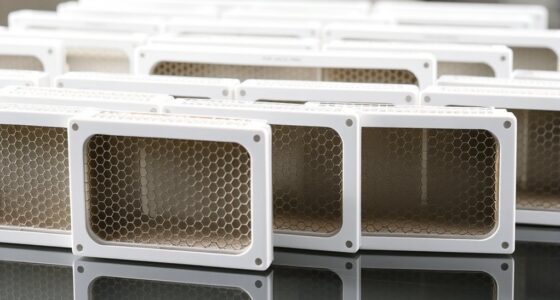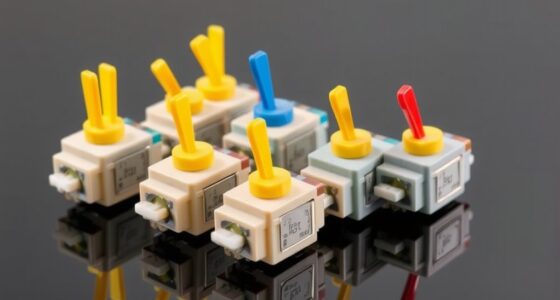If you’re looking for the best spare air quality sensors for Airthings monitors in 2025, I recommend considering trusted options like lab-grade sensors with high accuracy, such as NDIR for CO2 and electrochemical sensors for VOCs and gases. Compatibility, calibration ease, and long-term reliability are key factors. Brands that support seamless integration with Airthings systems guarantee consistent data. Keep exploring – you’ll find more essential tips and top recommendations below.
Key Takeaways
- Compatibility with Airthings devices using Bluetooth, Wi-Fi, or Zigbee for seamless sensor integration and data sharing.
- Support for multiple parameters like radon, CO2, VOCs, PM2.5, temperature, and humidity for comprehensive air quality monitoring.
- Availability of laboratory-grade sensors with high accuracy, low measurement error, and reliable long-term performance.
- Compatibility with smart home ecosystems for automation and remote alerts, ensuring trustworthy and customizable air quality management.
- Proven durability, warranty support, and positive user reviews from trusted brands preferred for dependable spare sensors.
Airthings 325 Corentium Home 2 Radon Detector

If you’re looking for a reliable, portable radon detector that provides real-time results without the hassle of lab fees, the Airthings 325 Corentium Home 2 is an excellent choice. It features Bluetooth connectivity, along with humidity and temperature sensors, ensuring accurate readings. Designed for long-term use, it continuously monitors radon levels and displays immediate data, helping you stay informed about fluctuations in your home. The companion app visualizes changes over time with clear graphs, enabling you to take action when needed. Trusted by professionals, this device combines proven accuracy with user-friendly features, making radon testing straightforward and dependable.
Best For: homeowners and industry professionals seeking a reliable, portable radon detector with real-time data and user-friendly features.
Pros:
- Provides immediate, accurate radon level readings without lab fees
- Bluetooth connectivity and sensors for humidity and temperature enhance measurement precision
- Visual data graphs and personalized guidance help users make informed decisions
Cons:
- Requires Bluetooth connection to use the app effectively, which may affect usability in some settings
- May be more expensive than basic radon detectors due to advanced features
- Designed primarily for long-term monitoring, so it may not be ideal for quick spot checks
Airthings 2960 View Plus Air Quality Monitor
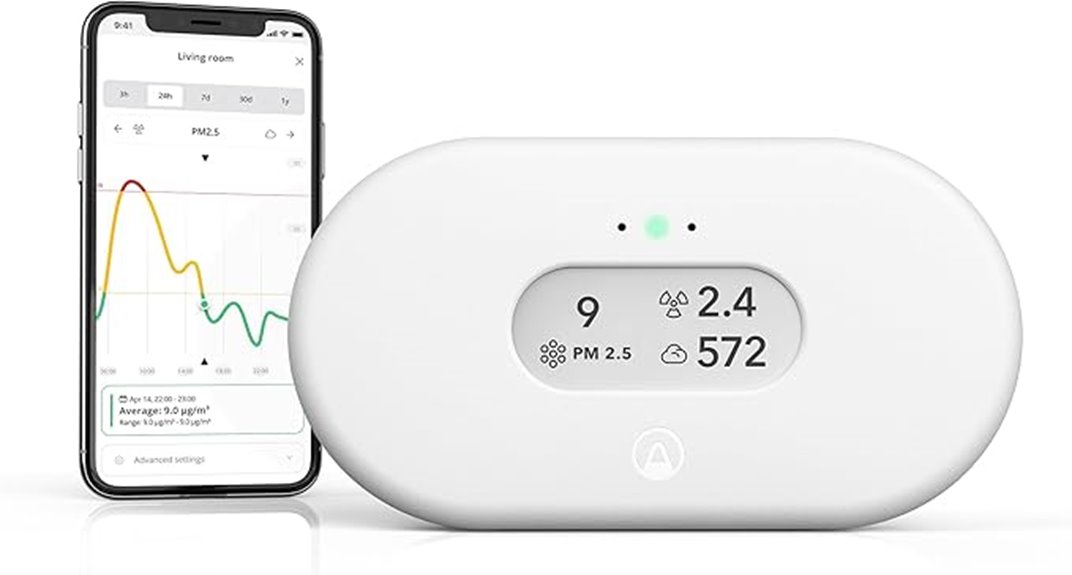
The Airthings 2960 View Plus Air Quality Monitor stands out for its extensive, real-time indoor air quality tracking, making it an excellent choice for health-conscious homeowners who want to monitor multiple pollutants simultaneously. It measures radon gas, PM2.5, CO2, VOCs, humidity, temperature, and air pressure with electrochemical sensors for accuracy. Radon detection is a key feature, given its link to lung cancer, and the device provides digital readings via an easy-to-read eInk screen. WiFi connectivity enables seamless data tracking, trend analysis, and alerts through the Airthings app. Battery-powered and cable-free, it’s simple to install and use, backed by a five-year warranty for added peace of mind.
Best For: health-conscious homeowners seeking comprehensive, real-time indoor air quality monitoring with a focus on radon detection.
Pros:
- Measures multiple pollutants including radon, PM2.5, CO2, VOCs, humidity, temperature, and air pressure for thorough indoor air assessment
- Easy-to-read eInk display and wireless setup provide user-friendly operation and flexible placement
- Reliable with a five-year warranty and secure cloud data storage for peace of mind
Cons:
- Requires WiFi and internet access for full functionality, which may be a limitation in some areas
- Battery-powered, so battery life and replacement need consideration over time
- The device’s advanced features and app integration may have a learning curve for some users
Amazon Smart Air Quality Monitor – Know your air, Works with Alexa
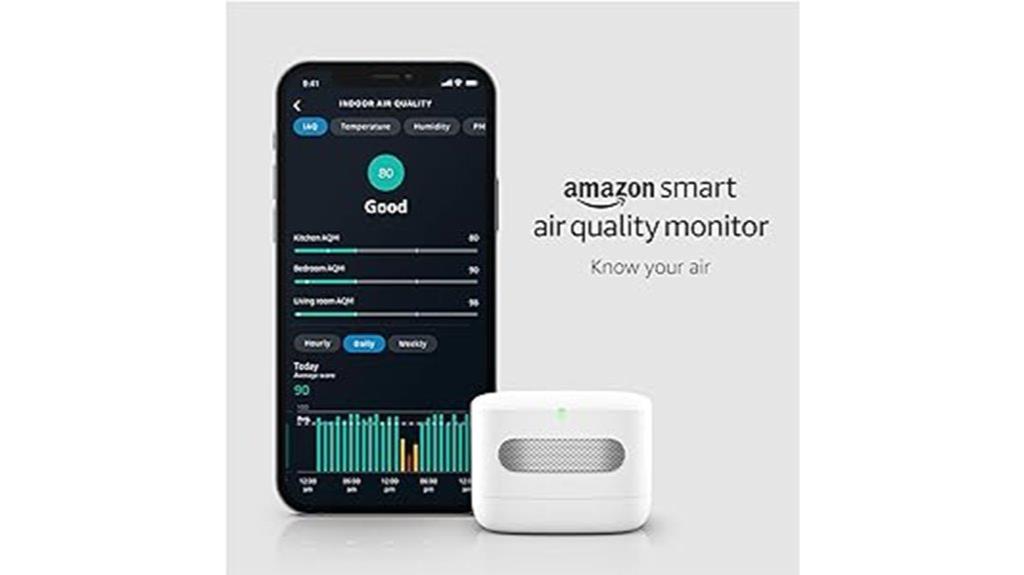
The Amazon Smart Air Quality Monitor is an excellent choice for homeowners who want real-time, actionable insights into their indoor air conditions. It tracks five key factors: PM 2.5, VOCs, CO, humidity, and temperature, displaying results with an easy-to-understand color-coded LED and air quality score via the Alexa app. It sends alerts to your phone or Echo devices if air quality drops, helping you respond quickly. You can also automate routines to activate purifiers or fans automatically. With simple setup and seamless Alexa integration, it makes managing indoor air quality effortless, ensuring a healthier, more comfortable home environment.
Best For: homeowners and smart home enthusiasts seeking real-time indoor air quality monitoring and automation to create a healthier, more comfortable living environment.
Pros:
- Tracks five key indoor air factors with easy-to-understand visual indicators and app scores.
- Seamless integration with Alexa allows for notifications, alerts, and automation routines.
- Simple, certified setup suitable for users of all experience levels.
Cons:
- Limited to indoor air quality monitoring; does not measure outdoor air conditions.
- Requires compatible Alexa devices for full automation features.
- May need additional smart devices (like air purifiers or fans) to fully automate air quality improvements.
Airthings-292 Wave Mini Indoor Air Quality Monitor

Airthings Wave Mini stands out as an ideal choice for anyone seeking a simple, battery-powered air quality monitor that can be easily placed anywhere indoors. Compact and cable-free, it measures TVOCs, humidity, and temperature, providing real-time data. Its easy-to-use design features a hand-activated color indicator that shows air quality at a glance. The device connects seamlessly to the free Airthings app via Bluetooth, allowing me to track trends and receive notifications. With a quick pass of my hand, I can check the current air conditions. Batteries last long, and setup is straightforward, making the Wave Mini a reliable and unobtrusive addition to any indoor space.
Best For: those seeking a simple, portable indoor air quality monitor to easily track VOCs, humidity, and temperature at home or in small indoor spaces.
Pros:
- Easy to activate with a quick hand pass, making it user-friendly and quick to check current air quality.
- Compact, battery-powered design allows flexible placement without the need for cables or power outlets.
- App integration offers real-time data, trend analysis, and notifications to help monitor and improve indoor air quality.
Cons:
- Limited to measuring only TVOCs, humidity, and temperature, without additional air quality parameters like particulate matter.
- Requires Bluetooth or a compatible hub for app connectivity, which may limit use in some setups.
- Battery life depends on usage, and replacement batteries are needed over time.
Airthings 2930 Wave Plus Radon & Air Quality Monitor
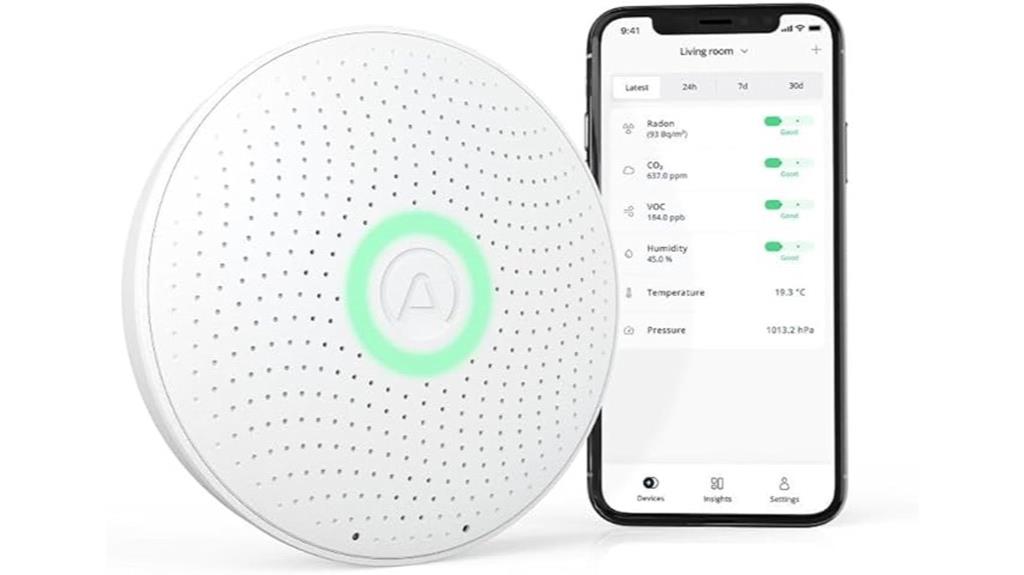
If you’re looking for a reliable air quality monitor that provides extensive insights, the Airthings 2930 Wave Plus Radon & Air Quality Monitor is an excellent choice. Designed in Norway and trusted worldwide, it measures radon, CO2, VOCs, humidity, temperature, and air pressure, giving you a comprehensive view of indoor air. Its long-term radon tracking ensures accurate results despite daily fluctuations. With Bluetooth connectivity, it easily syncs with the Airthings app for detailed analysis. The device is user-friendly, with clear, color-coded indicators. Its industry-standard sensors and reliable performance make it a top pick for anyone serious about indoor air quality in 2025.
Best For: households and individuals seeking comprehensive, reliable indoor air quality monitoring with long-term radon measurement and easy app connectivity.
Pros:
- Measures six key indoor air factors including radon, CO2, VOCs, humidity, temperature, and air pressure for thorough insights
- Long-term radon tracking provides accurate results despite daily fluctuations
- User-friendly with clear, color-coded indicators and Bluetooth connectivity to the Airthings app
Cons:
- Requires batteries, which need periodic replacement
- May involve additional costs for optional accessories or app features
- Limited to Bluetooth connectivity, which might be less suitable for users preferring Wi-Fi-based devices
GoveeLife Smart Air Quality Monitor
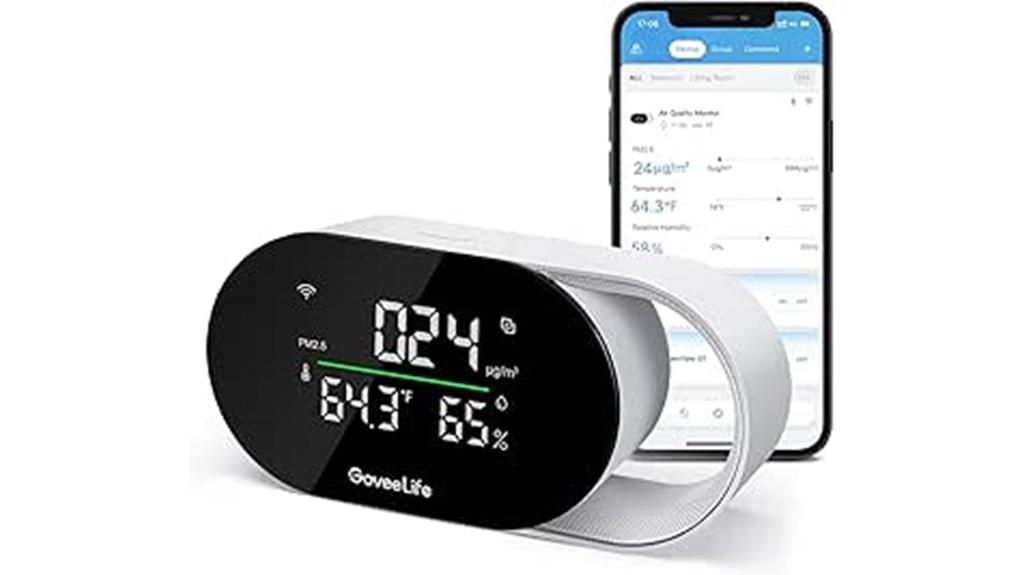
Anyone looking for an affordable, easy-to-use air quality monitor that provides real-time data will find the GoveeLife Smart Air Quality Monitor to be an excellent choice. Its sleek, compact design fits seamlessly into home or office spaces, measuring PM2.5, temperature, and humidity with quick updates every 2 seconds. The device features a clear LED display and supports remote monitoring via Bluetooth and Wi-Fi. It integrates smoothly with Govee’s smart home ecosystem, automating devices like air purifiers and humidifiers based on air quality. While it doesn’t track VOCs or CO2, many users appreciate its accuracy, affordability, and simple setup for ongoing indoor air management.
Best For: individuals seeking an affordable, easy-to-use indoor air quality monitor with real-time data and smart home integration.
Pros:
- Accurate measurement of PM2.5, temperature, and humidity with quick 2-second updates
- Sleek, compact design that seamlessly blends into home or office spaces
- Supports remote monitoring and automation with Govee’s smart home ecosystem
Cons:
- Does not monitor VOCs, CO2, or other pollutants, limiting comprehensive air quality assessment
- Occasional connectivity issues, especially with Wi-Fi on 2.4 GHz networks
- Lacks sensors for gases like CO or combustible gases, which could be useful for certain environments
Professional Indoor Air Quality Monitor, 5-in-1 Portable Smart Air Tester

The Professional Indoor Air Quality Monitor, 5-in-1 Portable Smart Air Tester, is ideal for those who need precise, real-time data on their indoor environment. It detects CO2, HCHO, TVOC, temperature, and humidity accurately, giving you detailed environmental insights. The high-definition color screen clearly displays data, with color-changing alerts for unsafe conditions. Equipped with advanced sensors like infrared (NDIR) and electrochemical sensors, it ensures high sensitivity and stability. Its simple operation, rechargeable battery, and portable design make it perfect for homes, cars, or on-the-go monitoring. I find it reliable for maintaining safe indoor air quality effortlessly.
Best For: individuals and families seeking accurate, real-time indoor air quality monitoring for homes, cars, or outdoor activities to ensure a safe environment.
Pros:
- Multi-function detection of CO2, HCHO, TVOC, temperature, and humidity for comprehensive environmental monitoring
- High-definition color display with color-changing alerts for easy interpretation of air quality status
- Portable design with rechargeable battery offers convenience for on-the-go use and various settings
Cons:
- Limited battery life of up to 8 hours may require frequent recharging during extended use
- May require calibration or maintenance of sensors for sustained accuracy over time
- Small size could limit the display’s visibility or ease of reading in bright or outdoor environments
Indoor Air Quality Monitor with AQI Beep Alarms and Portable Real-Time Detection
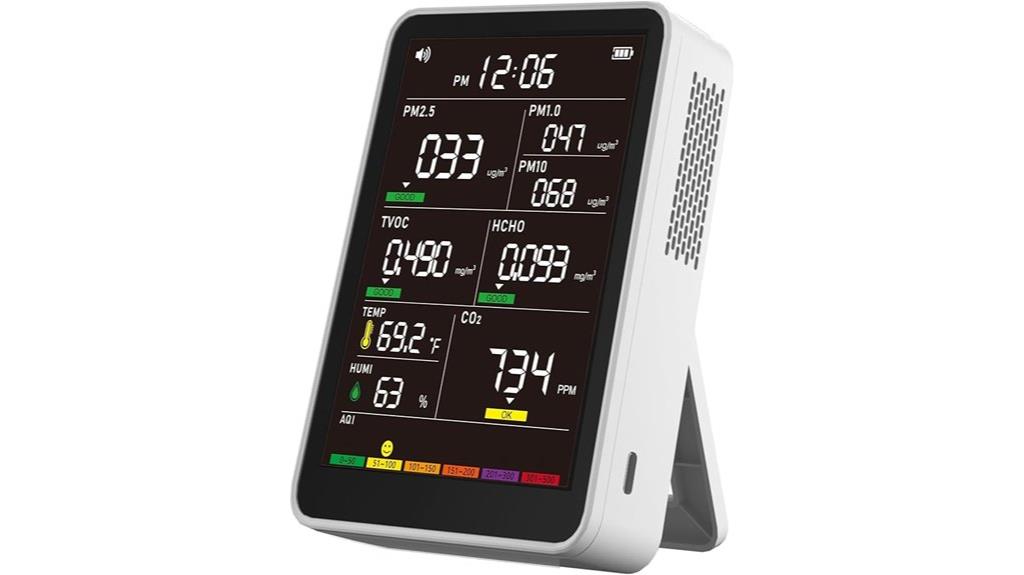
The Indoor Air Quality Monitor with AQI Beep Alarms and Portable Real-Time Detection is an ideal choice for anyone seeking quick, reliable air quality insights on the go. It detects PM1.0, PM2.5, PM10, CO2, TVOC, HCHO, temperature, and humidity in real time, with seven AQI alert buzzers for immediate notifications. Its user-friendly design includes a one-button start, easy alarm silencing, and a large HD display for clear readings. Powered by a high-performance battery, it provides 4-5 hours of continuous monitoring and quick charging. Its sleek design fits seamlessly into homes, cars, and outdoor spaces, backed by a 12-month warranty for peace of mind.
Best For: individuals seeking portable, real-time air quality monitoring for home, vehicle, or outdoor environments with immediate alerts.
Pros:
- Detects multiple air quality parameters including PM1.0, PM2.5, PM10, CO2, TVOC, and HCHO with real-time updates.
- Equipped with seven AQI alert buzzers for instant notifications of air quality changes.
- User-friendly with a one-button start, easy alarm silencing, and a clear HD color display.
Cons:
- Battery life of 4-5 hours may require frequent recharging during extended use.
- Limited to portable use, not suitable as a permanent fixed monitoring station.
- May be more expensive compared to simpler air quality monitors lacking multi-parameter detection.
Air Quality Monitor with CO2, HCHO, TVOC, Temperature & Humidity
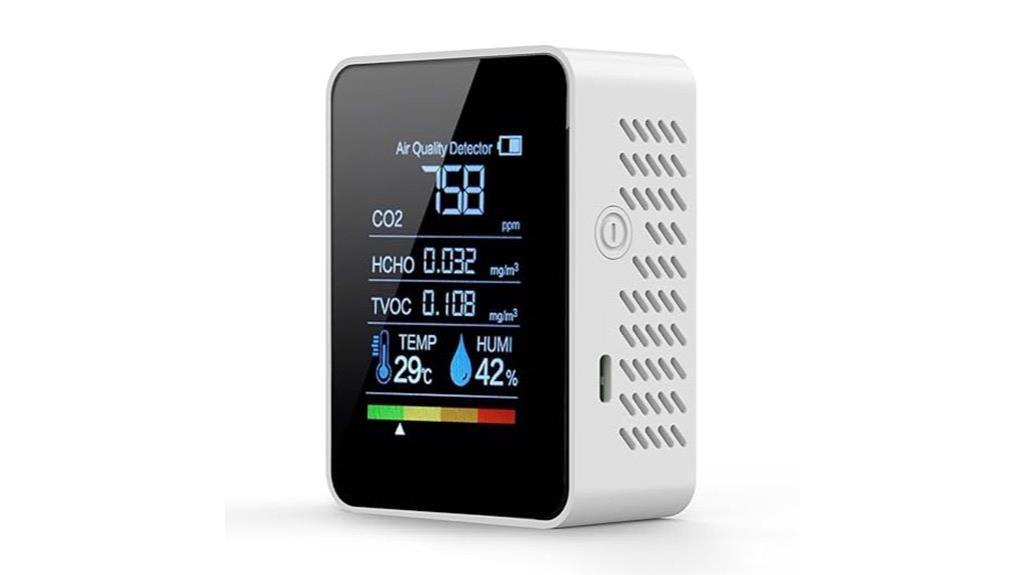
If you need a compact, easy-to-use device that provides real-time data on multiple indoor air quality parameters, this Air Quality Monitor is an excellent choice. It measures CO2, HCHO, TVOC, temperature, and humidity, offering a thorough view of your indoor environment. The device features a bright display, simple USB-C setup, and alerts for poor air quality, prompting quick action. Its portable design and up to 20 hours of battery life make it suitable for homes, offices, or on the go. Equipped with advanced sensors, it delivers accurate, real-time data to help you maintain healthier indoor air effortlessly.
Best For: individuals seeking a portable, easy-to-use indoor air quality monitor that provides real-time data on pollutants and climate conditions to maintain healthier living and working environments.
Pros:
- Compact, lightweight design ideal for on-the-go use and various locations
- Real-time, clear display of CO2, HCHO, TVOC, temperature, and humidity levels
- User-friendly setup with USB-C connection and alert reminders for poor air quality
Cons:
- Battery life may be shorter than the claimed 20 hours, with some users experiencing only a few hours of use
- Limited trend analysis or long-term monitoring features, especially without app integration
- Some measurements like humidity and temperature may vary slightly from other trusted devices
Air Quality Monitor Indoor, 8-in-1 Smart Air Quality Tester
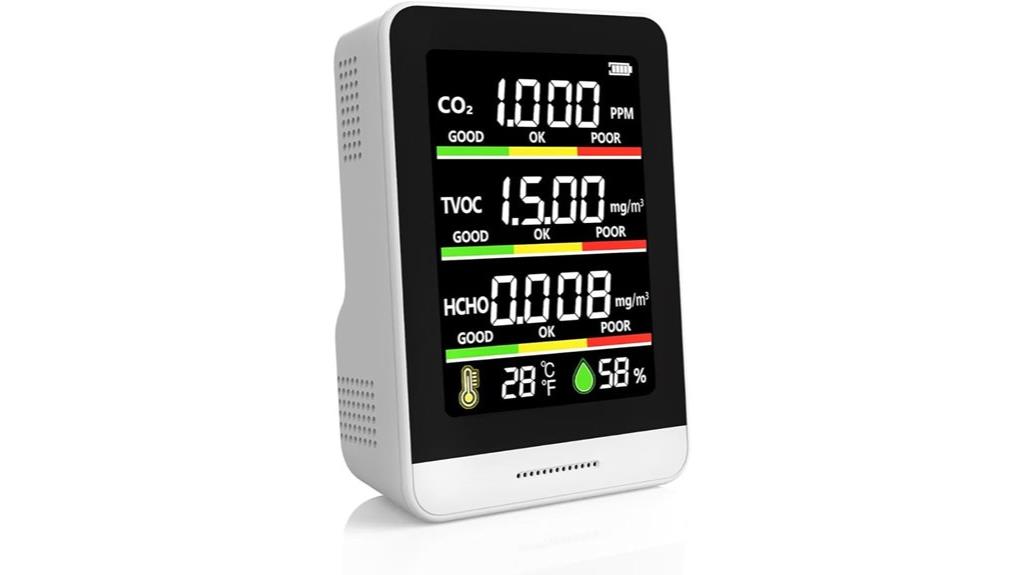
Looking for an indoor air quality monitor that’s both thorough and easy to use? The 8-in-1 Smart Air Quality Tester fits the bill perfectly. It measures AQI, CO2, HCHO, TVOC, temperature, and humidity, providing real-time data on a colorful, easy-to-read display. Compact and portable, it runs for about 9-10 hours on a single charge and responds swiftly to environmental changes. Its high-accuracy sensors ensure reliable readings within 0.5% error. Simple controls and an audible alarm make monitoring straightforward, whether in your home or office. This device helps me stay aware of air quality and act quickly to maintain a healthy space.
Best For: anyone seeking an easy-to-use, accurate indoor air quality monitor to maintain a healthy and comfortable living or working environment.
Pros:
- Provides comprehensive 8-in-1 measurements including AQI, CO2, HCHO, TVOC, temperature, and humidity for complete air quality assessment.
- Features a large, colorful display with color-coded data for quick and clear interpretation.
- Compact, portable, and long-lasting with a 9-10 hour battery life, ideal for continuous monitoring in various spaces.
Cons:
- May have a learning curve for users unfamiliar with air quality metrics despite simple controls.
- Limited to indoor use; does not monitor outdoor air conditions directly.
- Slight measurement error of around 0.5%, which may be critical for highly sensitive applications.
Bonoch 16-in-1 Indoor Air Quality Monitor with AQI Alerts
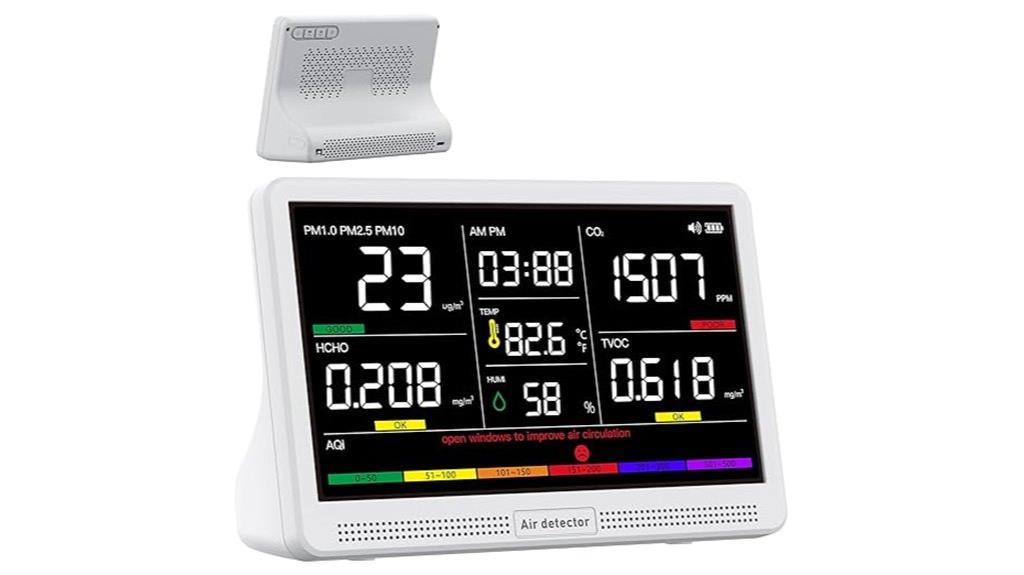
For anyone serious about maintaining a healthy indoor environment, the Bonoch 16-in-1 Indoor Air Quality Monitor with AQI Alerts offers unmatched accuracy and real-time notifications. It measures nine critical parameters, including CO2, PM levels, formaldehyde, TVOC, temperature, and humidity, all displayed clearly on a 7-inch LED screen. Its high-precision external sensors detect even minor air quality shifts with lab-grade precision. The device features customizable AQI alerts and seven warning buzzers for pollutants, enabling proactive responses. User-friendly controls allow quick adjustments, and its sleek design fits seamlessly into any home. Overall, it’s a thorough, reliable tool for safeguarding indoor air quality.
Best For: individuals and families seeking comprehensive, real-time indoor air quality monitoring to ensure a healthy living environment.
Pros:
- Measures nine essential air quality parameters with lab-grade accuracy for reliable data.
- Features a large, adjustable 7-inch LED display for easy reading in various lighting conditions.
- Customizable AQI alerts and multiple warning buzzers enable proactive health management.
Cons:
- External high-precision sensors require careful handling to maintain accuracy.
- The device may be more expensive compared to simpler air quality monitors.
- Limited to indoor use, not suitable for outdoor air quality monitoring.
Airthings View Pollution PM2.5 Air Quality Monitor
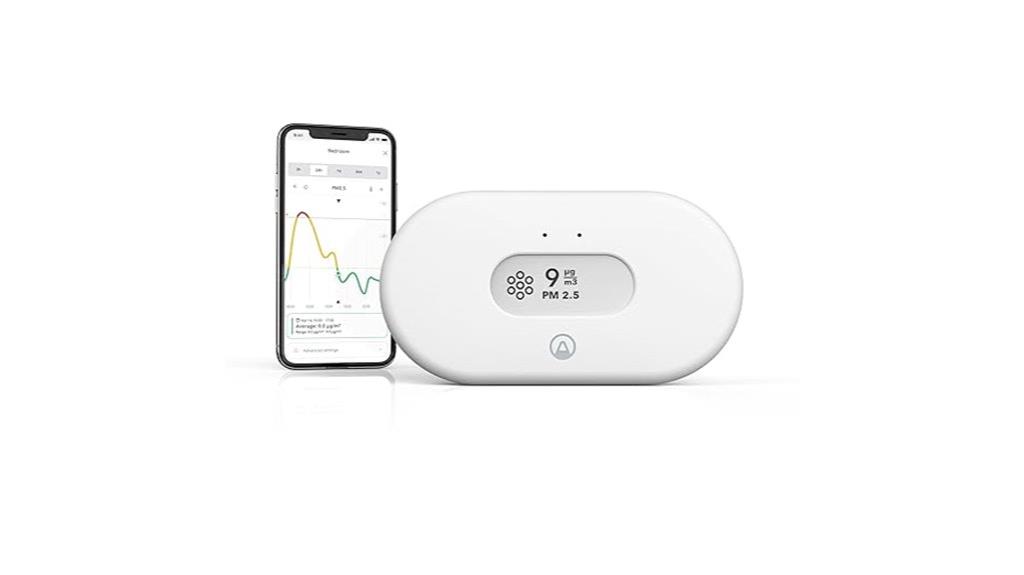
The Airthings View Pollution PM2.5 Air Quality Monitor stands out as an ideal choice for residents in urban areas, wildfire-prone regions, or individuals with respiratory conditions. It provides real-time tracking of PM 2.5, humidity, and temperature, helping you stay ahead of pollution from city smog or wildfire smoke. The device’s customizable eInk display and wave gestures make it easy to check levels quickly, while its wireless design offers flexible placement. With up to two years of battery life and seamless app integration, it delivers ongoing insights and alerts. This monitor empowers me to maintain healthier indoor air and reduce health risks effectively.
Best For: urban residents, wildfire-prone communities, and individuals with asthma or allergies seeking real-time indoor air quality monitoring.
Pros:
- Provides continuous, real-time data on PM 2.5, humidity, and temperature for proactive air quality management
- Wireless design with up to two years of battery life allows flexible placement without cords
- Customizable eInk display and wave gestures enable quick, easy access to key sensor readings and alerts
Cons:
- May require WiFi connectivity for full feature access, which could be problematic in low-signal areas
- Limited to indoor use; not suitable for outdoor air quality monitoring
- Some users might find the initial setup or app interface less intuitive than expected
16-in-1 Indoor Air Quality Monitor with Display and Alerts
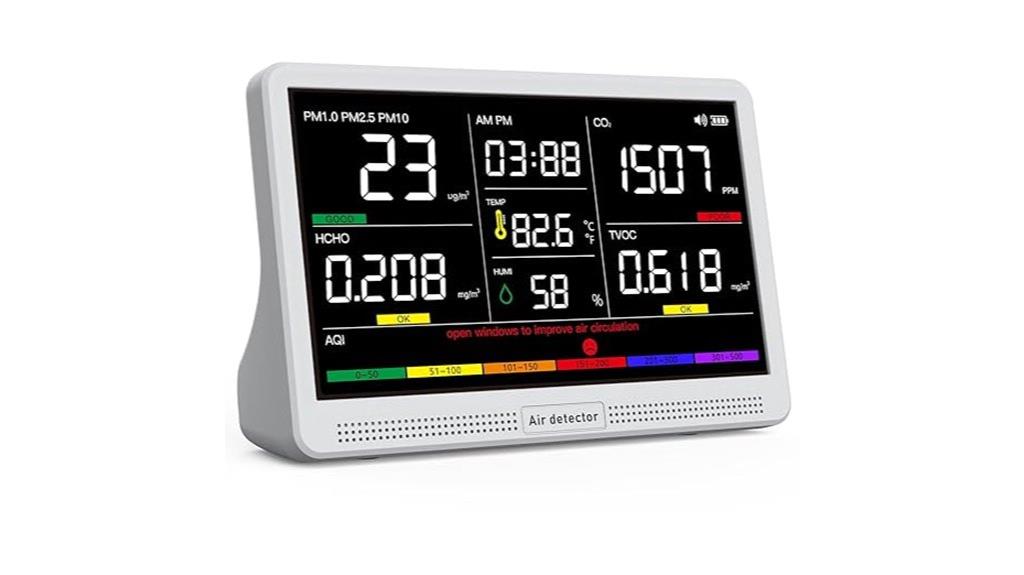
The in-1 Indoor Air Quality Monitor with Display and Alerts stands out for its extensive detection capabilities, making it ideal for people who want a thorough understanding of their indoor environment. It detects nine key parameters, including CO2, PMs, HCHO, TVOC, temperature, humidity, and AQI, providing real-time data on air quality. Its large 7-inch LED display shows all readings clearly, with customizable brightness. The device features seven alert buzzers and a color-coded bar for quick status checks, plus easy setup and user-friendly controls. Its high-precision sensors deliver reliable measurements, helping me monitor pollutants and decide when to ventilate or purify indoor air effectively.
Best For: individuals and households seeking comprehensive real-time indoor air quality monitoring with easy-to-read displays and alert notifications.
Pros:
- Detects nine key environmental parameters for thorough air quality assessment
- Large 7-inch LED display with customizable brightness for clear visibility
- User-friendly setup with intuitive controls and real-time data updates
Cons:
- Primarily operates on wall power, limiting portability and placement options
- Some skepticism regarding the accuracy of CO2 readings compared to professional devices
- Bulky design may affect flexible placement in smaller spaces
12-in-1 Indoor Air Quality Monitor, Portable Air Quality Tester
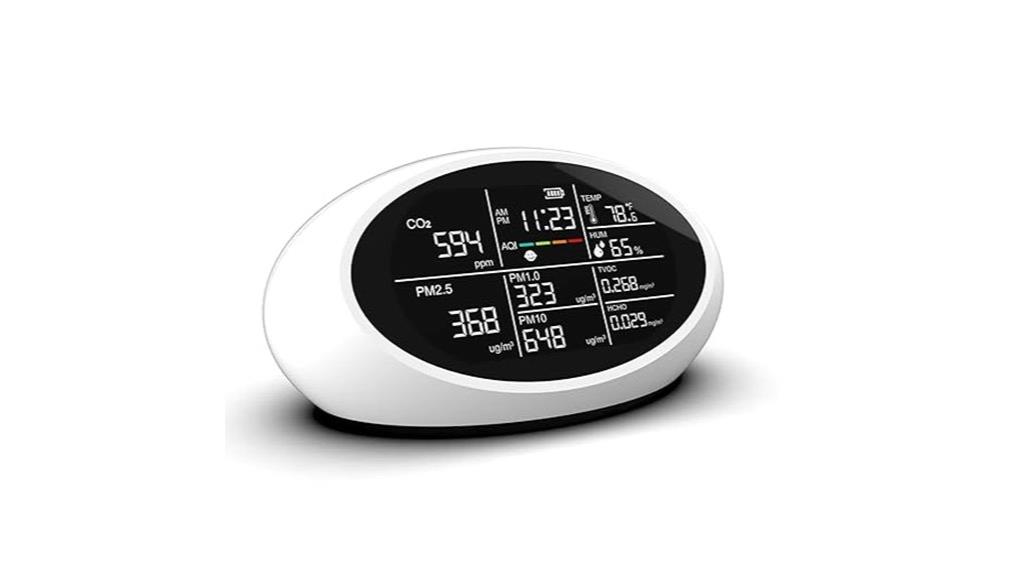
Anyone looking for a portable air quality tester that delivers thorough data will find the Rozoroo 12-in-1 Indoor Air Quality Monitor an excellent choice. It’s sleek, skin-friendly, and suitable for various environments like home, office, or car. With a powerful 5000 mAh battery, it supports both wireless and wired use, making it easy to move around. Setup is quick—about a minute—thanks to intuitive controls. The device measures CO2, TVOC, HCHO, PM levels, humidity, temperature, and more, providing real-time, high-accuracy data. Its safety features, like CO2 alarms and AQI smiley indicators, help me quickly assess indoor air quality and ensure a healthy environment wherever I go.
Best For: individuals seeking a portable, comprehensive air quality monitor to ensure healthy indoor environments at home, work, or on the go.
Pros:
- Provides real-time, high-accuracy measurements for multiple air quality parameters including CO2, TVOC, HCHO, and particulate matter.
- Portable and stylish design with a long-lasting 5000 mAh battery for wireless and wired use.
- User-friendly interface with quick setup and intuitive controls, along with safety features like alarms and AQI indicators.
Cons:
- May require periodic calibration to maintain maximum accuracy over time.
- The device’s advanced features could be overwhelming for users unfamiliar with air quality metrics.
- Limited details on data storage or connectivity options beyond basic monitoring functions.
BREATHE Airmonitor Plus: Smart Indoor Air Quality Monitor

If you’re seeking a thorough indoor air quality monitor that offers accurate, real-time data across multiple pollutants, BREATHE Airmonitor Plus is an excellent choice. It measures PM1, PM2.5, PM10, CO2, TVOC, formaldehyde, temperature, and humidity, providing a comprehensive view of indoor air conditions. Equipped with high-precision sensors, it delivers reliable readings and connects easily via Wi-Fi to the free Breathe Tech App, allowing remote monitoring, trend analysis, and alerts. Its portable design, with a built-in battery, makes testing multiple rooms simple. Easy setup and an intuitive interface make it accessible for everyone, helping you create a healthier indoor environment.
Best For: individuals seeking a comprehensive, real-time indoor air quality monitor to ensure a healthier living environment with easy remote access and tracking.
Pros:
- Measures 8 key indoor air quality parameters for thorough monitoring.
- Connects via Wi-Fi to a user-friendly app for remote tracking, alerts, and data export.
- Portable with a built-in battery, allowing testing in multiple rooms or outdoor areas.
Cons:
- Limited battery life (2-3 hours), restricting extended portable use.
- Occasional Wi-Fi connectivity issues, especially with certain networks.
- Lacks Bluetooth setup and local data logging options for offline use.
Factors to Consider When Choosing a Spare Air Quality Sensor for Airthings Monitor
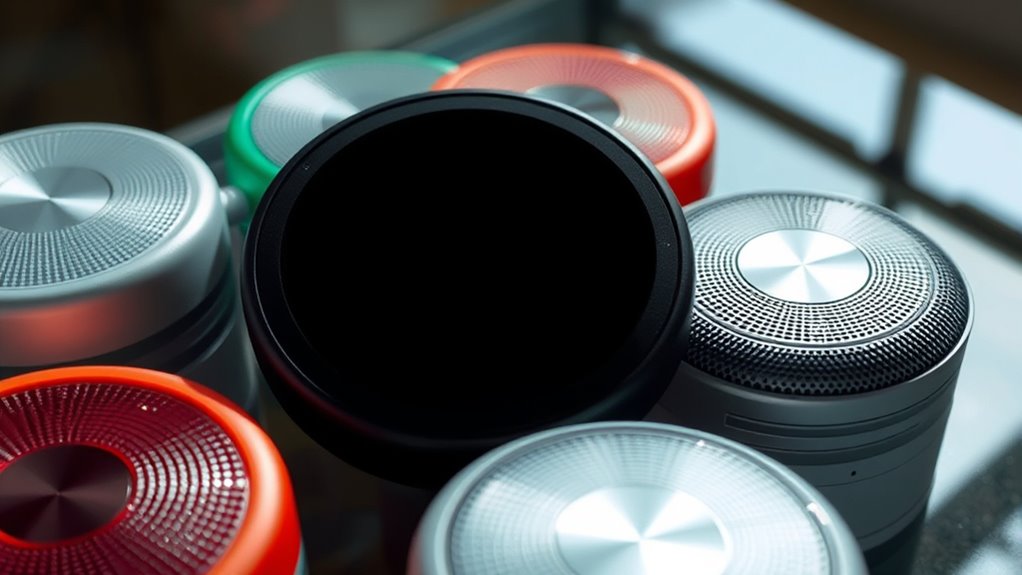
When choosing a spare air quality sensor for my Airthings monitor, I focus on key factors like compatibility standards and sensor accuracy to guarantee reliable readings. I also consider device connectivity options and power supply needs to keep everything running smoothly. Finally, I check maintenance and calibration requirements to sustain ideal performance over time.
Compatibility Standards
Choosing a spare air quality sensor for your Airthings monitor requires careful attention to compatibility standards to guarantee smooth operation. First, verify the sensor uses the same communication protocol, like Bluetooth, Wi-Fi, or proprietary links, as your main device to ensure seamless integration. Next, confirm that the sensor’s connectors and interface match the specifications of your Airthings model. It’s also essential to check for compliance with industry standards such as CE, FCC, or RoHS, which confirm safety and regional compatibility. Additionally, confirm that the firmware and software are compatible with your existing monitor’s version to prevent operational issues. Finally, review the sensor’s calibration and measurement range to ensure they align with your monitor’s expected parameters, ensuring accurate and reliable readings.
Sensor Accuracy Levels
Sensor accuracy levels are a crucial factor in selecting a spare air quality sensor for your Airthings monitor because they directly impact the reliability of the readings you receive. Higher accuracy sensors typically have measurement errors within ±1-3% for gases like CO2 and VOCs, providing more dependable data. Sensors with greater precision can detect smaller fluctuations in pollutant levels, which is essential for early warning and detailed monitoring. Calibration frequency also affects accuracy; high-precision sensors require regular calibration to maintain their reliability. External sensors using advanced detection technologies, such as NDIR for CO2 or laser scattering for particulates, usually offer superior accuracy. These specifications are usually detailed in datasheets, helping you choose sensors that closely match laboratory-grade measurements for trustworthy results.
Device Connectivity Options
Device connectivity options play a pivotal role in guaranteeing your spare air quality sensor integrates smoothly with your Airthings monitor. I recommend verifying that the sensor supports your monitor’s connectivity features, such as Bluetooth, Wi-Fi, or SmartLink hubs. It’s important to check whether the device pairs wirelessly or requires a physical connection like USB. App-based integration is also valuable for seamless data transfer and real-time monitoring, so confirm that the sensor’s app is compatible with your system. Additionally, guarantee the sensor supports your network setup, including 2.4 GHz or 5 GHz Wi-Fi bands, for reliable communication. Finally, features like firmware updates and remote access can enhance connectivity performance and make managing your sensor more convenient.
Power Supply Compatibility
When selecting a spare air quality sensor to pair with your Airthings monitor, it’s important to contemplate how it’s powered. You want to guarantee the sensor’s voltage and current specifications match your device to keep everything functioning smoothly. Check if the sensor uses built-in rechargeable batteries, replaceable batteries, or if it’s powered via USB or an external power adapter. Compatibility of the power connector type—like USB-C, a proprietary port, or a battery compartment—is also vital for easy replacement. Additionally, consider whether the sensor’s power management features support long-term, continuous operation, especially if you plan to run it around the clock. Ultimately, verify that your existing power sources, such as wall outlets or power banks, can support the sensor’s power needs without interruptions.
Maintenance and Calibration
Regular calibration is essential to keep air quality measurements accurate over time, preventing drift that could lead to false readings. Most sensors need calibration at least once every 6 to 12 months, depending on usage and environmental factors. Using standardized reference gases or calibration kits recommended by the manufacturer guarantees measurements stay aligned with industry standards. Proper maintenance also involves cleaning sensor surfaces periodically and replacing filters or parts as specified, which prevents contamination that can impair accuracy. Consistent calibration and maintenance not only improve measurement reliability but also extend the lifespan of sensors, reducing costly replacements. When selecting a spare sensor, consider those that offer easy calibration procedures and clear maintenance guidelines, ensuring you can keep your air quality data trustworthy over the long term.
Frequently Asked Questions
How Compatible Are Spare Sensors With Different Airthings Monitor Models?
When it comes to spare sensors for Airthings monitors, I find compatibility varies between models. I always check the specific sensor type and model requirements before purchasing, as not all sensors work with every device. Airthings generally designs sensors for particular monitors, so I recommend consulting the product specs or support to guarantee the spare sensor matches your monitor. This way, I avoid any incompatibility issues and keep my air quality readings accurate.
What Is the Typical Lifespan of Spare Air Quality Sensors?
Like a ticking clock, the lifespan of spare air quality sensors varies, but generally, they last about 2 to 3 years. Regular calibration and proper storage can extend their accuracy. I recommend checking the manufacturer’s guidelines, as some sensors might need replacement sooner or last longer depending on usage. Staying attentive to sensor performance helps guarantee your air quality readings stay reliable.
Do Spare Sensors Require Calibration Before Use?
When I get spare air quality sensors, I always check if they need calibration before use. Most sensors are pre-calibrated, so I usually don’t need to calibrate them right away. However, it’s a good idea to review the manufacturer’s instructions to guarantee accuracy, especially if they’ve been stored for a while. Proper calibration ensures reliable readings, helping me trust my monitor’s data completely.
Are Spare Sensors Compatible With Smart Home Automation Systems?
When it comes to spare sensors, I’ve found that compatibility with smart home automation systems varies. Most modern sensors are designed to integrate seamlessly, especially if they use common protocols like Zigbee or Z-Wave. I always double-check the specifications before buying. If you’re like me, ensuring compatibility means you can automate alerts and control your environment effortlessly, making your smart home smarter and safer.
How Do Spare Sensors Impact Overall Air Quality Monitoring Accuracy?
When I think about spare sensors, I realize they play a key role in maintaining accurate air quality readings. They act as backups, ensuring continuous monitoring even if the primary sensor fails or needs calibration. This redundancy helps me trust the data more, knowing my air quality is consistently tracked. Overall, spare sensors improve the reliability and accuracy of monitoring systems, giving me peace of mind about the air I breathe.
Conclusion
Choosing the right spare air quality sensor feels like revealing the secret to healthier indoor air. Imagine a device quietly working in the background, just like a trusted guardian, detecting unseen pollutants before they become a problem. When you pick a reliable monitor, you’re not just investing in technology — you’re safeguarding your loved ones’ well-being. It’s like having a personal air detective that guarantees every breath you take is safe and pure.
